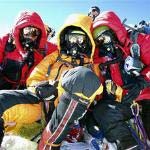
FAITH LAPIDUS: I'm Faith Lapidus.
STEVE EMBER: And I'm Steve Ember with EXPLORATIONS in VOA Special English. Today, we tell about efforts to climb Mount Everest. In May, a 13-year-old American boy became the youngest person to climb the tallest mountain on Earth.
(MUSIC)
FAITH LAPIDUS: Mount Everest is at the border of Nepal and Tibet. It was named for Sir George Everest, who recorded the mountain's position in 1841. Since 1953, more than 10,000 people have attempted to climb to the top of the world's highest mountain. The summit of Mount Everest is 8,848 meters high.
Climbers have reached the summit more than 3,000 times. However, more than 200 people died while attempting to get there. Most climbers make the trip in late April and May when weather conditions are the least severe.
All climbers battle extreme conditions: Low temperatures. Wind speeds of up to 160 kilometers an hour. Dangerous mountain paths. And they all risk developing a serious health disorder caused by lack of oxygen. All for the chance to reach the top of the world.
STEVE EMBER: The first and most famous of the climbers to disappear on Mount Everest was George Mallory. The British schoolteacher was a member of the first three trips by foreigners to the mountain. In 1921, Mallory was part of the team sent by the British Royal Geographical Society and the British Alpine Club.
The team was to create the first map of the area and find a possible path to the top of the great mountain.
Mallory also was a member of the first Everest climbing attempt in 1922. But that attempt was canceled after a storm caused a giant mass of snow to slide down the mountain, killing seven ethnic Sherpa guides.
FAITH LAPIDUS: Mallory was invited back to Everest as lead climber of another expedition team in 1924. On June 4th, Mallory and team member Andrew Irvine left their base camp for the team's final attempt to reach the summit. The climbing team had great hopes of success for the two men. A few days earlier, expedition leader Edward Norton had reached a record height of 8,573 meters before he turned back.
STEVE EMBER: Mallory and Irvine were using bottles of oxygen. Mallory believed that was the only way they would have the energy and speed to climb the last 300 meters to the top and return safely. Team member Noel Odell saw Mallory and Irvine climbing high on the mountain the following day.
Odell said they had just climbed one of the most difficult rocks on the northeast path. He said they were moving toward the top when clouds hid them. He never saw them again. The disappearance of Mallory and Irvine on Mount Everest remains among the greatest exploration mysteries of the last century.
In 1999, climbers set off to search for the remains of Mallory and Irvine. They were hoping to find a camera that might contain a picture, which would prove whether or not the men reached the summit. They did not find a camera, but they found the body of George Mallory. The body gave many clues about how Mallory might have died. But the debate continues as to whether this famous team reached the top of Mount Everest.
(MUSIC)
FAITH LAPIDUS: During the next 29 years after Mallory and Irvine's effort, teams from Britain made seven more attempts to climb Everest. Until the early 1950s, British teams were the only foreigners given permission to climb Mount Everest.
On May 29th, 1953, Edmund Hillary and Tenzing Norgay became the first climbers known to reach the summit of Everest. The two were part of a British team lead by Jon Hunt. They had made a difficult climb from the southeast, through recently opened Nepalese territory.

Edmund Hillary was a beekeeper from New Zealand. It was his second trip to Everest. He had been on the first exploratory trip to the mountain that had mapped the way up from the southern side. Tenzing Norgay was a native Sherpa from Nepal. His climb with Hillary was his seventh attempt to reach the top.
STEVE EMBER: Hillary said his first reaction on reaching the summit was a happy feeling that he had "no more steps to cut." The two men placed the flags of Britain, Nepal, India and the United Nations. Hillary took a picture of Norgay. They looked out over the north side into Tibet for any signs that Mallory or Irvine had been there before them. Then they began the long and difficult trip back down. The success of Edmund Hillary and Tenzing Norgay led to many new attempts on the mountain. Today, Everest has been climbed from all of its sides and from most of its possible paths.
(MUSIC)
FAITH LAPIDUS: In 1975, Junko Tabei from Japan became the first woman to reach the summit of Everest.
Reinhold Messner of Italy and Peter Habeler of Austria made another historic climb three years later. The two men were the first to reach the summit without using bottled oxygen. Messner said when he reached the top he felt like a single giant lung.
At the time, scientists believed that a person at the top of the mountain would only have enough oxygen to sleep. Scientists believed that Messner and Habeler would die without oxygen. Scientists now know that two conditions make climbing at heights over 8,000 meters extremely difficult. The first is the lack of oxygen in the extremely thin air. The second is the low barometric air pressure.
STEVE EMBER: Today, scientists say a person dropped on the top of the mountain would live no more than ten minutes. Climbers can survive above 8,000 meters because they spend months climbing on the mountain to get used to the conditions.
Several things have made climbing Everest easier now than it was for the first climbers. These include modern equipment and clothing. They also include information gained from earlier climbs and scientific studies.
Hundreds of people have reached the summit each year during the past few years. Some expert climbers have begun leading guided trips up the mountain.
Some people have paid as much as 65,000 dollars for the chance to climb Everest. However, many of these people have little climbing experience. This can lead to serious problems.
FAITH LAPIDUS: In 1996, Everest had its greatest tragedy. Fifteen people died attempting to reach the top. This was the deadliest single year in Everest history. A record ten people died on the mountain in one day. Two of the world's best climbers were among those killed. Several books by climbers have described the incident and the dangerous conditions. The best known is "Into Thin Air," a personal story about the disaster by Jon Krakauer. The book sold many copies around the world and increased the interest in climbing Mount Everest.
(MUSIC)
STEVE EMBER: This year has been a successful one for Mount Everest climbers. The Website Everestnews.com says over 440 people reached the top of the world's highest mountain.
Last month, 13-year-old Jordan Romero became the youngest person to reach the top of the mountain. He was influenced at the age of nine by a painting in his school of the highest mountains on the seven continents.

FAITH LAPIDUS: The eighth grader from California climbed Everest with a team that included his father, his stepmother and three Sherpas. Jordan said that on the climb he began to have intense stomach pains. But as he reached the top, he said the pain went away and he only felt happiness. He said the feeling of accomplishment would be with him for the rest of his life. He even remembered to telephone his mother. He told her that he was calling from the top of the world.
Jordan's next goal is to climb Vinson Massif in Antarctica. After that climb, he will have completed his goal of climbing the seven summits.
STEVE EMBER: Another record was set last month. The Nepali mountain guide Apa is also known as "Super Sherpa." He reached the summit of Everest for the 20th time. He dedicated this climb to the effect of climate change on the Himalayan Mountains. He said he is upset by the many changes he sees caused by rising temperatures on Everest. He said the melting snow is making the climb much more dangerous.
(MUSIC)
FAITH LAPIDUS: This program was written by Shelley Gollust and Dana Demange who was also the producer. I'm Faith Lapidus.
STEVE EMBER: And I'm Steve Ember. You can comment about this story on our website, voaspecialenglish.com. You can also find us on Facebook, Twitter and iTunes at VOA Learning English. Join us again next week for EXPLORATIONS in VOA Special English.
44歲韓國女性征服14座高峰 創(chuàng)世界紀(jì)錄
'Cleaning-climbers' promote green tourism in Yemen
(來源:VOA 編輯:陳丹妮)
